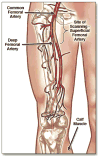Superficial femoral artery plaque and functional performance in peripheral arterial disease: walking and leg circulation study (WALCS III)
- PMID: 21757163
- PMCID: PMC3906625
- DOI: 10.1016/j.jcmg.2011.04.009
Superficial femoral artery plaque and functional performance in peripheral arterial disease: walking and leg circulation study (WALCS III)
Abstract
Objectives: We studied associations of magnetic resonance imaging measurements of plaque area and relative percent lumen reduction in the proximal superficial femoral artery with functional performance among participants with peripheral arterial disease.
Background: The clinical significance of directly imaged plaque characteristics in lower extremity arteries is not well established.
Methods: A total of 454 participants with an ankle brachial index <1.00 underwent magnetic resonance cross-sectional imaging of the proximal superficial femoral artery and completed a 6-min walk test, measurement of 4-m walking velocity at usual and fastest pace, and measurement of physical activity with a vertical accelerometer.
Results: Adjusting for age, sex, race, body mass index, smoking, statin use, comorbidities, and other covariates, higher mean plaque area (1st quintile [least plaque]: 394 m, 2nd quintile: 360 m, 3rd quintile: 359 m, 4th quintile: 329 m, 5th quintile [greatest plaque]: 311 m; p trend <0.001) and smaller mean percent lumen area (1st quintile [greatest plaque]: 319 m, 2nd quintile: 330 m, 3rd quintile: 364 m, 4th quintile: 350 m, 5th quintile: 390 m; p trend <0.001) were associated with shorter distance achieved in the 6-min walk test. Greater mean plaque area was also associated with slower usual-paced walking velocity (p trend = 0.006) and slower fastest-paced 4-m walking velocity (p trend = 0.003). Associations of mean plaque area and mean lumen area with 6-min walk distance remained statistically significant even after additional adjustment for the ankle brachial index and leg symptoms.
Conclusions: Among participants with peripheral arterial disease, greater plaque burden and smaller lumen area in the proximal superficial femoral artery are associated independently with poorer functional performance, even after adjusting for the ankle brachial index and leg symptoms.
Copyright © 2011 American College of Cardiology Foundation. Published by Elsevier Inc. All rights reserved.
Figures



References
-
- Fuster V, Fayad ZA, Moreno PR, Poon M, Corti R, Badimon JJ. Atherothrombosis and high-risk plaque. Part II: approaches by noninvasive computed tomographic/ magnetic resonance imaging. J Am Coll Cardiol. 2005;46:1209–18. - PubMed
-
- Yuan C, Mitsumori LM, Ferguson MS, et al. In vivo accuracy of multi-spectral magnetic resonance imaging for identifying necrotic cores and intra-plaque hemorrhage in advanced human carotid plaques. Circulation. 2001;104:2051–6. - PubMed
-
- Yao ST, Hobbs JT, Irvine WT. Ankle systolic pressure measurements in arterial disease affecting the lower extremities. Brit J Surg. 1969;56:676–9. - PubMed
-
- McDermott MM, Liu K, Criqui MH, et al. Ankle-brachial index and subclinical cardiac and carotid disease: the multi-ethnic study of atherosclerosis. Am J Epidemiol. 2005;162:33–41. - PubMed
Publication types
MeSH terms
Grants and funding
LinkOut - more resources
Full Text Sources
Medical

